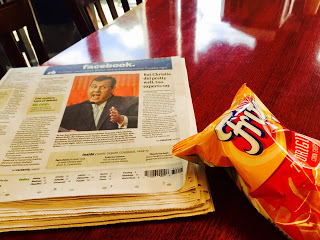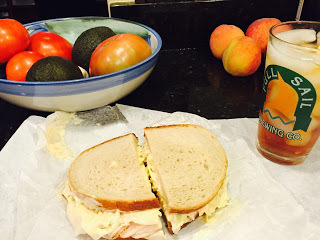More Setting
Or maybe the title should be more ABOUT setting.
Goodness knows, I've blogged a few times about setting.
Just when I think I've got it figured out, I don't. Ever have that feeling?
Maybe I need a WORKSHEET.
Maybe I need a trip. Much as I love New Jersey, I could never set a novel for young readers here. Oh yes, we have our local color, but is it suitable for young eyes?

(seen at the local deli)
And we have great food! But it's not food from my childhood. In fact, my children never cared much for NJ specialties so how could I possibly write about them.

(This is a Sloppy Joe. If you have never lived in NJ, it takes some explaining.)
Where a story takes place is almost as important to me as who is telling the story. That's why I've been noodling around to see what others have to say on the subject. I don't want to overdo the Spanish moss, the lizards, the pimento cheese.
Here's what I'm learning- I'll share a few links:
I love what Barbara O'Connor says about HOLES.
And she's said many things about setting over the life of her blog.
I have a tattered old notebook on a shelf with a few quotes from my favorite books: On the Road to Mr. Mineo's, for example.
("lazy days of summer stretch out before them like the highway out by the Waffle House" says more than most people could say in 3 paragraphs.)
And there's this: http://www.writing-world.com/fiction/settings.shtml
Or this: http://writeitsideways.com/21-writing-prompts-for-setting-a-scene-in-your-novel/
Also in that notebook-
A great memory of the Writers in Paradise week with Ann Hood. I love #1.
A few notes:
In all writing, the focus should be right there at the beginning, in the first sentences. We should know where we are and what we are in for.
1. Picture sentences. Close your eyes. If you can't picture it, it needs help.
2. In non-fiction, use all the devices of fiction: dialogue, setting, character, action, climax, resolution.
3. Find a central metaphor (examples: knitting, fire), something that gives your story meaning.
Okay, writer and reader friends. Can setting by overdone? Does it limit the audience, especially in books for young readers? Do you have tricks to share with the rest of us? How exactly do you bring your scenes alive?
Goodness knows, I've blogged a few times about setting.
Just when I think I've got it figured out, I don't. Ever have that feeling?
Maybe I need a WORKSHEET.
Maybe I need a trip. Much as I love New Jersey, I could never set a novel for young readers here. Oh yes, we have our local color, but is it suitable for young eyes?

(seen at the local deli)
And we have great food! But it's not food from my childhood. In fact, my children never cared much for NJ specialties so how could I possibly write about them.

(This is a Sloppy Joe. If you have never lived in NJ, it takes some explaining.)
Where a story takes place is almost as important to me as who is telling the story. That's why I've been noodling around to see what others have to say on the subject. I don't want to overdo the Spanish moss, the lizards, the pimento cheese.
Here's what I'm learning- I'll share a few links:
I love what Barbara O'Connor says about HOLES.
And she's said many things about setting over the life of her blog.
I have a tattered old notebook on a shelf with a few quotes from my favorite books: On the Road to Mr. Mineo's, for example.
("lazy days of summer stretch out before them like the highway out by the Waffle House" says more than most people could say in 3 paragraphs.)
And there's this: http://www.writing-world.com/fiction/settings.shtml
Or this: http://writeitsideways.com/21-writing-prompts-for-setting-a-scene-in-your-novel/
Also in that notebook-
A great memory of the Writers in Paradise week with Ann Hood. I love #1.
A few notes:
In all writing, the focus should be right there at the beginning, in the first sentences. We should know where we are and what we are in for.
1. Picture sentences. Close your eyes. If you can't picture it, it needs help.
2. In non-fiction, use all the devices of fiction: dialogue, setting, character, action, climax, resolution.
3. Find a central metaphor (examples: knitting, fire), something that gives your story meaning.
Okay, writer and reader friends. Can setting by overdone? Does it limit the audience, especially in books for young readers? Do you have tricks to share with the rest of us? How exactly do you bring your scenes alive?
Published on August 08, 2015 11:55
date newest »
newest »
 newest »
newest »




In fact, I often return to an old favorite book and suddenly realize that I've been picturing a place that's completely different from the one clearly--or even exhaustively--described by the author.
But the places I imagine while I read are always vivid and complete. I suspect I keep my own mental file of "stock" locations--castle, desert, southern town, whaling ship--and set whatever I'm reading into the appropriate one, unless some event in the story forces me to adjust it.
Definitely food for thought. . . .